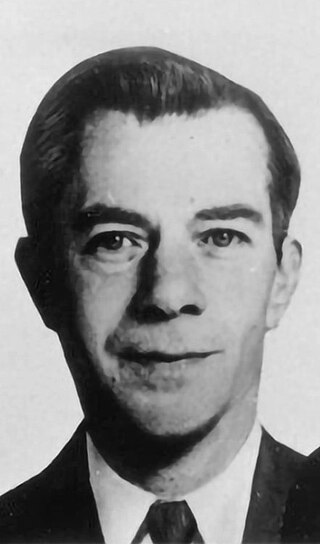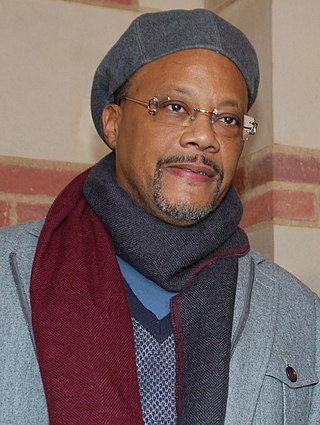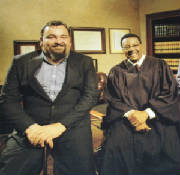
William Francis Sutton Jr. was an American bank robber. During his forty-year robbery career he stole an estimated $2 million, and he eventually spent more than half of his adult life in prison and escaped three times. For his talent at executing robberies in disguises, he gained two nicknames, "Willie the Actor" and "Slick Willie". Sutton is also known as the namesake of the so-called Sutton's law, although he denied originating it.

Gregory Ellis Mathis, known professionally as Judge Mathis, is a former Michigan 36th District Court judge, television court show arbitrator, author, television producer, and motivational speaker.

Judge Mathis is an American arbitration-based reality court show presided over by Judge Greg Mathis, a former judge of Michigan's 36th District Court and Black-interests motivational speaker/activist.

The Mexican Mafia, also known as La eMe, is a predominantly Mexican American prison gang and criminal organization in the United States. Despite its name, the Mexican Mafia has no origins in Mexico and is entirely a U.S. organization. Law enforcement officials report that the Mexican Mafia is the deadliest and most powerful gang within the California prison system.
The Irish Mob is a usually crime family–based ethnic collective of organized crime syndicates composed of primarily ethnic Irish members which operate primarily in Ireland, the United States, the United Kingdom, Canada and Australia, and have been in existence since the early 19th century. Originating in Irish-American street gangs – famously first depicted in Herbert Asbury's 1927 book, The Gangs of New York – the Irish Mob has appeared in most major U.S. and Canadian cities, especially in the Northeast and the urban industrial Midwest, including Boston, New York City, Philadelphia, Pittsburgh, Baltimore, Cleveland, and Chicago.
Kkangpae (Korean: 깡패) is a romanization of the Korean word that is commonly translated to 'gangster' or 'thug'. The term is commonly used to refer to members of unorganized street gangs. By contrast, members of organized crime gangs are called geondal (건달) or jopok.
In the late 19th and early 20th centuries, African American organized crime emerged following the first and second large-scale migration of African Americans from the Southern United States to major cities of the Northeast, Midwest, and later the West Coast. In many of these newly established communities and neighborhoods, criminal activities such as illegal gambling, speakeasies and were seen in the post-World War I and Prohibition eras. Although the majority of these businesses in African American neighborhoods were operated by African Americans, it is often unclear the extent to which these operations were run independently of the larger criminal organizations of the time.
The Forty-Two Gang was a teenage street gang in Chicago that started during Prohibition. Like Brooklyn's Italian and Jewish street gangs of Brownsville and Ocean Hill, the Forty-Two Gang served as a "farm team" for future members of the Chicago Outfit. Forty-Two Gang members included future syndicate members Sam Giancana, Sam "Teets" Battaglia, Luigi "Cockeyed Louie" Fratto, Felix "Milwaukee Phil" Alderisio, "Mad Sam" DeStefano, Charles "Chuckie" Nicoletti, Fiore "Fifi" Buccieri, William "Smokes" Aloisio, Frank "Skids" Caruso, William "Willie Potatoes" Daddano, Joseph DiVarco, Marcello Caifano, Mario DeStefano, Bruno Tassione, and Joey "Cowboy" Miletta.
The East Harlem Purple Gang was a gang and organized crime group in New York City consisting of Italian-American hit-men and heroin dealers who were semi-independent from the Italian-American Mafia and, according to federal prosecutors, dominated heroin distribution in East Harlem, Italian Harlem, and the Bronx during the 1970s and early 1980s. Though mostly independent of the Mafia and not an official Mafia crew, the gang was originally affiliated with and worked with the Lucchese crime family and later with the Bonanno crime family and Genovese crime family. It developed its "closest ties" with the Genovese family, and its remnants or former members became part of the Genovese family's 116th Street Crew.
Born to Kill, also known as BTK or Canal Boys, was a New York City-based street gang composed of first-generation Vietnamese immigrants. They were active in the 1980s in New York City's Chinatown. The early 1990s proved to be detrimental to the Vietnamese collective following the arrest and prosecution of most of their New York-based operatives by the fall of 1992.

The Avenues, also known as Avenidas or AVE's, is a Mexican/Mexican American criminal street gang mostly in Los Angeles County, California. They originally started as a social club for local Latino youths to protect themselves from other violent youths. The Avenues, like most Mexican gangs in Los Angeles, are under the direct control of the Mexican Mafia when sent to State, County, or Federal prisons.

Sureños , also known as Southern United Raza, Sur 13 or Sureños X3, are groups of loosely affiliated gangs that pay tribute to the Mexican Mafia while in U.S. state and federal correctional facilities. Many Sureño gangs have rivalries with one another, and the only time this rivalry is set aside is when they enter the prison system. Thus, fighting is common among different Sureño gangs even though they share the same common identity. Sureños have emerged as a national gang in the United States.

Armenian Power 13, also known as AP, the Armenian Mob, or Armenian Mafia is an Armenian criminal organization and street gang founded and currently based in Los Angeles County, California. They are involved in drug trafficking, murder, assault, fraud, identity theft, illegal gambling, kidnapping, racketeering, robbery and extortion. They are believed to have around 200 members and hundreds of associates, according to the U.S. attorney’s office. They are also well known for their connections with the Mexican Mafia.

The Purple Gang, also known as the Sugar House Gang, was a criminal mob of bootleggers and hijackers composed predominantly of Jewish gangsters. They operated in Detroit, Michigan, during the 1920s of the Prohibition era and came to be Detroit's dominant criminal gang. Excessive violence and infighting caused the gang to destroy itself in the 1930s.

Adrian Donohoe was an Irish detective in the Garda Síochána based at Dundalk Garda Station in County Louth, who was fatally shot in Bellurgan on 25 January 2013 during a robbery by an armed gang of five people on a credit union. He was the first garda officer to be murdered in the line of duty since 1996, and was afforded a full state funeral.
The Dubois Brothers, also known as the Dubois gang, were a French-Canadian organized crime group consisting of nine brothers, which operated mostly in Montreal in the 1950s to the mid-1980s. The Dubois Brothers first gained their reputation for their criminal behaviour and their toughness throughout their teenage years. By the 1960s the Dubois Brothers were gaining control and were becoming the only crime group in Montreal that were considered to rival the Cotroni family in the 1960s and 1970s. The Dubois Brothers engaged in extortion, the exploitation of strippers and prostitutes, drug trafficking, loan sharking, and the murder of rival victims. A report by the Quebec Crime Commission called the gang "the most important criminal organization in Quebec," so vicious and strong that they were known to be feared by both outlaw motorcycle gangs and the nearby Mafia.

David Thai,, is a Vietnamese-born American gangster who was the founder and leader of the notorious Born to Kill gang during the late 1980s and early 1990s. He was also responsible for running a massive illegal counterfeit watch operation and at his peak controlled the market and distribution of counterfeit watches in New York by means of "blackmail and extortion." He was the official leader of "New York Vietnamese Born to Kill" from 1988 until his arrest in 1991, which was the combination of months of investigation by the United States Bureau of Alcohol, Tobacco, Firearms and Explosives (ATF) in conjunction with the aid of a former gang member who defected from the gang and became an undercover informant, helping secure the convictions of David Thai and several of his high-ranking officers.
Vineland Boys is a street gang composed mainly of Hispanic Americans operating in the San Fernando Valley area of Los Angeles.









